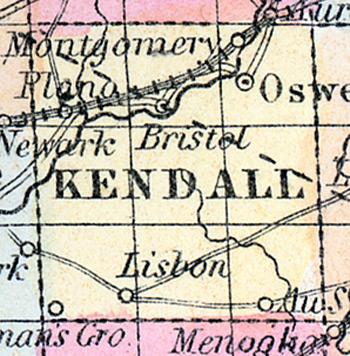KENDALL COUNTY, situated on the northeasterly part of Illinois, and traversed by Fox river. Area, 324 square miles. Seat of justice, Yorkville. Pop. in 1850, 7,730. (Fanning's, 1853)
KENDALL, a county in the N. E. part of Illinois, has an area of 325 square miles. It is intersected by Fox river, which flows southwestward, and also drained by the sources of Au Sable river. The surface is undulating prairie, diversified with fine groves of timber. The soil is uniformly and highly productive. Wheat, Indian corn, oats, hay, and pork are the staples. In 1850 this county produced 410,986 bushels of Indian corn; 213,660 of wheat; 139,008 of oats; 14,700 tons of hay, and 180,270 pounds of butter. It contained 10 churches, and 3556 pupils attending public schools. Quarries of good building stone are worked near the county seat. Fox river is a rapid and copious stream, affording valuable water-power. Two plank-roads are in progress in the county, which is intersected by the Aurora Extension railroad. Capital, Oswego. Population, 7730. (Baldwin's New and Complete Gazetteer of the United States..., 1854)
KENDALL COUNTY Is situated in the north-east part of the state, and has an area of 325 square miles. It is intersected by Fox river, which flows southwestward, and also drained by the sources of Au Sable river. The surface is undulating prairie, diversified with fine groves of timber. The soil is highly productive. It contains about 20 churches, and has over 4,000 pupils attending public schools. Good building stone is found in some sections of the county. Fox river affords ample water power for milling and manufacturing purposes. The Burlington and Quincy railroad crosses the northern portion of the state. Capital, Oswego. Population, about 10,500. (Hawes' Illinois State Gazetteer...,1859)

